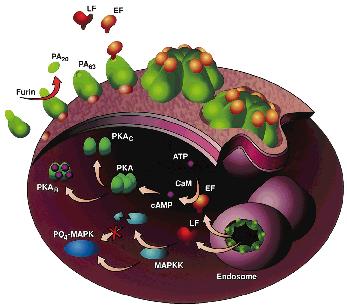Mechanism of Entry
Inhalational anthrax is the most lethal version of the three infections. After inhaling dormant spores your immune system responds and destroys many of them. Some, however, are carried to the lymph nodes in the chest by macrophages, germinate, and begin their destructive activity by initiating capsule and toxin production and entry into the bloodstream. Lethal Factor (LF) and Edema Factor (EF) need the activity of Protective Antigen to gain entry into the cell. Protective Antigen (PA), binds to the von Willebrand factor type A domain of the Anthrax Toxin Receptor (ATR) (5) on the cell surface of many cells, most importantly macrophages, and is cleaved by a furin protease which recognizes a RKKR sequence (8). Removal of this sequence prevents cleavage and inactivates it. The carboxy portion, named PA63 remains bound to the receptor while the amino portion, PA20, is released to the medium. Several of the membrane receptors with bound PA63 coalesce and form a heptamer, to which either EF or LF can bind. (PA + EF is the edema toxin and PA + LF is the lethal toxin). This complex is then endocytosed and as the endosome becomes more acidic, the heptamer changes conformation, inserts into the membrane and becomes a channel protein which facilitates translocation of EF or LF into the cytosol (7). See
Lethal Factor and Edema Factor for their activity.
Mechanism of Entry (4)